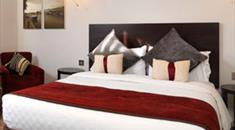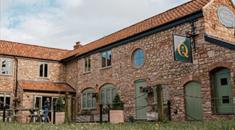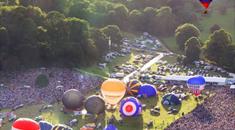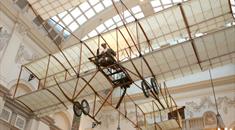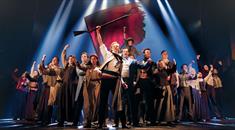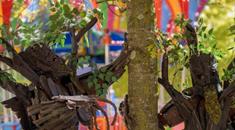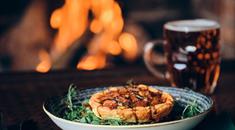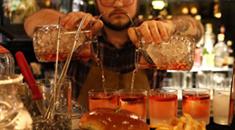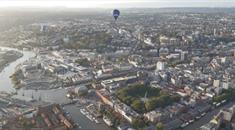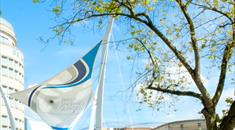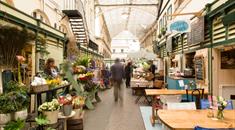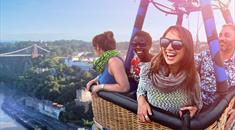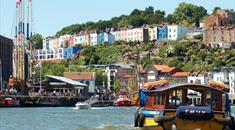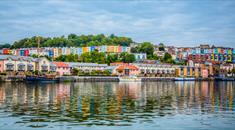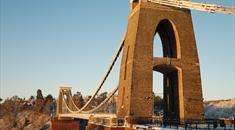Described as a compact history and celebration of the city, The Little History of Bristol is the latest book by local writer Maurice Fells.
It promises to surprise even life-long Bristolians who thought they knew all there is to know about this city. And it’s the perfect size to take along on walks, so you can discover intriguing trivia about places as you pass them.
In this guest article, Maurice highlights eight of the Bristol curiosities he covers in the book, featuring everything from an unusual knighting to a Bristolian dinosaur.
Published by The History Press, order your copy of The Little History of Bristol here.
Animal magic
Bristol Zoo Gardens was the fifth oldest zoo in the world. It was opened in 1836 on twelve acres of farmland on the edge of Clifton and Durdham Downs. The zoo’s most popular resident was Alfred the gorilla who was an orphan from the Congo. He was often seen walking around the zoo gardens wearing his trademark cardigan accompanied by one of his keepers. Alfred was so popular that visitors from all over the world sent him birthday cards on September 5 which was the day he arrived at the zoo in 1930. He died in 1948.
.jpg)
Image - Alfred the gorilla, credit Bristol Zoo Gardens
Knighted on the street
Normally knighthood ceremonies are held by the monarch in the grand surroundings of Buckingham Palace. But, believe it or not, on one occasion Queen Victoria knighted one prominent Bristolian on an unprepossessing street pavement in the heart of Bristol.
It happened in 1889 when she was on her way to open a nursing home near Clifton and Durdham Downs. After arriving by train the Queen transferred to a horse drawn carriage for the short journey to the Council House, then in Corn Street. Kneeling on the pavement – covered by a red carpet – was the Mayor of Bristol, Cllr. Herbert Ashman. Queen Victoria borrowed a sword from a member of her entourage, leant out of her carriage, dubbed the Mayor on the shoulder and commanded him to “Arise Sir Herbert Ashman”. No one knows why the Queen didn’t leave her carriage.
The first citizen
Bristol has an unbroken record of Mayors and Lord Mayors – sometimes called First Citizen – since 1216. The name of each one is engraved on a wall in the Conference Hall in City Hall. The first Mayor was Roger Cordewaner and the last was Cllr. Herbert Ashman. After Queen Victoria announced in 1899 that Bristol would have a Lord Mayor the first one was Herbert Ashman.
Aspiring to great heights
Until recently Bristol’s tallest building was St. Mary Redcliffe Church with its ‘cloud piercing’ spire rising 292 feet above street level. It’s been overtaken by a new residential tower block close to Castle Park. In a tweet the Rev. Dan Tyndall said: “We’ve held the record since 1874. So we’ve had our fair share of that accolade. Will the new tallest building still hold that title in 2166?”
Two thirds of the spire collapsed during a lightning storm in 1446 and because of shortage of funds wasn’t replaced for more than 400 years. St. Mary Redcliffe is often mistaken for a cathedral because of its space and grace.
Still the fairest, though! https://t.co/rjt0wmlauR
— St Mary Redcliffe Church (@stmaryredcliffe) December 15, 2020
The Lord Mayor’s Chapel
Bristol City Council is the only local authority in the land to own and maintain a church. It's known as the Lord Mayor's Chapel although it's dedicated to St. Mark and it doesn't have a parish although services are held there. The chapel was created in 1220 and stands on College Green facing Bristol Cathedral. It was bought by the council when Henry VIII dissolved the monasteries. St. Mark’s Chapel and all the land it owned cost the council £1,000.
The City’s High Cross
The medieval Civic High Cross was a landmark for several centuries, originally standing at the junction of Corn Street, Wine Street, High Street and Broad Street, then the centre of Bristol. The brightly painted and gilded cross had four niches in which were installed statues of four Plantagenet kings.
In 1633 the Cross was heightened and four more statues of monarchs added. Not everybody was impressed, though. John Vaughan, a wealthy banker living nearby, claimed that his life and property were in danger when the cross started shaking in high winds. It was removed to College Green alongside Bristol Cathedral. However, it wasn’t long before more complaints were made. This time people said the High Cross prevented them from promenading – a craze at the time of people walking up to ten abreast. So it was taken down again and this time stored in pieces in the cathedral’s cloisters.
Did you know that Bristol's medieval High Cross was not only a place where civic pronouncements were made but it was also the site if decapitations! More on this in my forthcoming book https://t.co/p3hXu35hgn
— maurice fells (@mauricefells) March 10, 2021
The last the citizens of Bristol saw of their monument was when six horse-drawn wagons, each carrying various parts of the cross, left the cathedral heading for Wiltshire. Apparently, the Dean of Bristol, had given the cross to his friend Henry Hoare, a collector of antiques, who installed it on his estate at Stourhead Park. It has stood there since 1768 and is now maintained by the National Trust, which owns Stourhead Park.
However, the saga of the High Cross was not over in Bristol by any means. A replica of it was commissioned and erected on College Green where it stayed until 1950 when the land was lowered. Somehow, the replica found its way into a builder’s yard where it was left to crumble. Conservation groups raised funds to restore it. Part of the replica now stands almost hidden – in a corner of a communal garden in Berkeley Square, Clifton.
‘My first child, my darling’
Isambard Kingdom Brunel’s Clifton Suspension Bridge gracefully spanning the Avon Gorge is often regarded as Bristol’s ‘trademark’. Construction work started in 1830 but came to a standstill several times as funds ran out. Eventually the bridge was completed in 1864 as a monument to Brunel who had died five years earlier. He had called the bridge ‘My first child, my darling’.
It’s not generally known that the Clifton end of the bridge is three feet higher than the other side. Brunel designed it way to create a level appearance because of the topography of the area.
.jpg)
Image - Clifton Suspension Bridge, credit Angharad Paull
Bristol’s own dinosaur
From the natural history records we know that Bristol even had its own dinosaur known as thecodontosaurus. It lived on tropical islands in the Bristol area during the Triassic period around 210 million years ago. Fossilised bones of a thecodontosaurus were found in a quarry on Clifton and Durdham Downs in 1834. It was the fourth species of dinosaur to be identified anywhere in the world.
About the author
Maurice Fells is a born and bred Bristolian who is passionate about the city's rich seam of history. The Little History of Bristol is his thirteenth book. He has held key editorial posts in regional newspapers and television and now works as a freelance journalist and author. He's a familiar voice on radio stations talking about local history. You can follow Maurice on Twitter and buy The Little History of Bristol now.
You might also like:




 to add an item to your Itinerary basket.
to add an item to your Itinerary basket.










